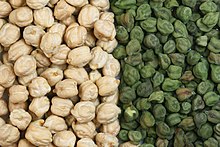**Chickpea Overview:**
– Etymology: Chickpea name derived from Latin word ‘cicer’, ‘garbanzo’ from Old Spanish word ‘arvanço’
– History: Domestication around 7000 BC, spread to Mediterranean by 6000 BC, cultivation in India by 3000 BC
– Description: Plant grows 20-50cm high, white flowers with blue, violet, or pink veins, dozens of varieties globally
**Chickpea Varieties:**
– Desi type common in South Asia, Ethiopia, Mexico, and Iran
– Desi variety in Apulia and Basilicata, Italy
– American and Iranian chickpeas sweeter than Indian chickpeas
– Kermanshah chickpeas in sizes 8 and 9 among highest quality
– Various global chickpea varieties cultivated
**Chickpea Nutrition:**
– Rich in energy, protein, fiber, essential vitamins, and minerals
– Contains iron, phosphorus, magnesium, folate in significant amounts
– Nutrient-dense, providing essential amino acids like lysine, isoleucine, tryptophan
– Mainly unsaturated fatty acids, with significant linoleic acid content
– Cooked chickpeas composition: 60% water, 27% carbohydrates, 9% protein, 3% fat
**Culinary and Cooking Uses:**
– Chickpea flour (besan) in various dishes like pakoras, sweets, flatbreads
– Used in dishes like Burmese tofu, socca, panisse in different cuisines
– Chickpeas in desserts like Mysore pak, savory snacks like guasanas garbanza
– Aquafaba as egg white substitute, also used in animal feed
– Cooking effects: Improve protein quality, digestibility, modify protein-fiber complexes
**Health Benefits and Research:**
– Lower trypsin and chymotrypsin inhibitors, aiding digestion
– Positive effects on egg production, growth of birds, pigs, milk quality in ruminants
– Good source of dietary fiber, aiding digestion and gut health
– Potential benefits in managing weight, reducing chronic disease risks
– Under research for nutrition improvement, impact on chronic diseases; preliminary studies ongoing
The chickpea or chick pea (Cicer arietinum) is an annual legume of the family Fabaceae, subfamily Faboideae. Its different types are variously known as gram or Bengal gram, chhana, chana, or channa, garbanzo or garbanzo bean, or Egyptian pea. Chickpea seeds are high in protein. It is one of the earliest cultivated legumes, the oldest archaeological evidence of which was found in Syria.
| Chickpeas | |
|---|---|

| |
| Dried chickpeas. The larger light tan kabuli and variously coloured desi are the two main types of chickpea. They are green when picked early and vary through tan or beige, speckled, dark brown to black. 75% of world production is of the smaller desi type. | |

| |
| Sprouted chickpea | |
| Scientific classification | |
| Kingdom: | Plantae |
| Clade: | Tracheophytes |
| Clade: | Angiosperms |
| Clade: | Eudicots |
| Clade: | Rosids |
| Order: | Fabales |
| Family: | Fabaceae |
| Subfamily: | Faboideae |
| Genus: | Cicer |
| Species: | C. arietinum
|
| Binomial name | |
| Cicer arietinum | |
| Synonyms | |
| |

The chickpea is a key ingredient in Mediterranean and Middle Eastern cuisines, used in hummus, and, when soaked and coarsely ground with herbs and spices then made into patties and fried, falafel. As an important part of Indian cuisine, it is used in salads, soups and stews, and curry, in chana masala, and in other food products that contain channa (chickpeas). In 2019, India was responsible for 70% of global chickpea production.
